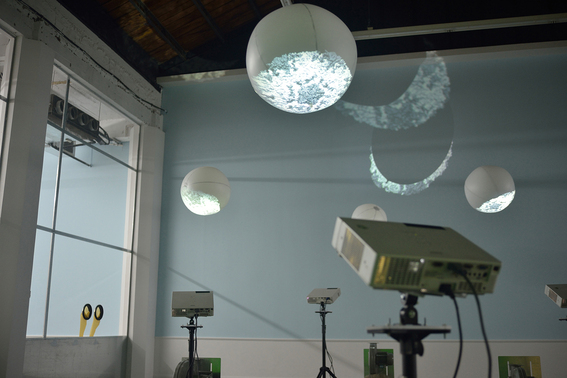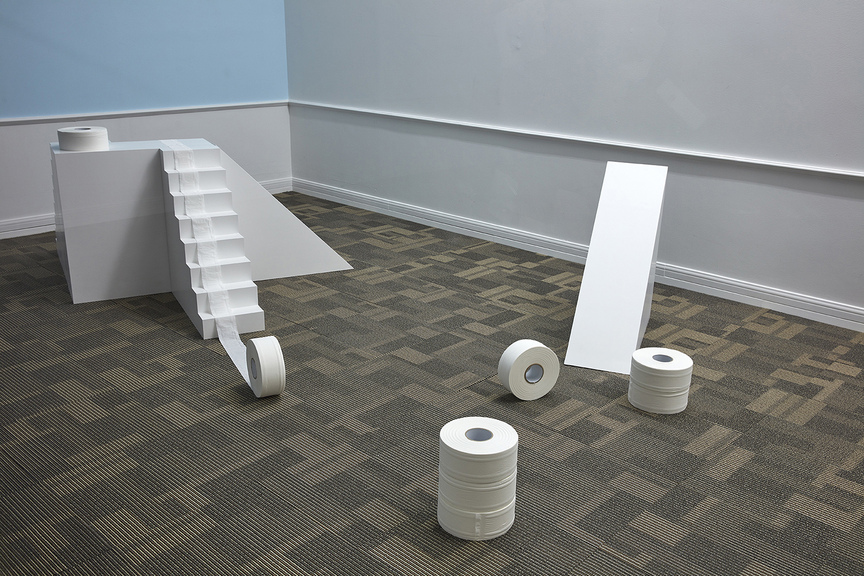-
From Current Issue
-
- Editor’s Letter Fire in the Heart
- Reviews I Gusti Ayu Kadek Murniasih
- Reviews 11th Seoul Mediacity Biennale: “One Escape at a Time”
- Dispatch Networked China
- One on One Monira Al Qadiri on Yukio Mishima
- Essays The rise of independent art spaces in pandemic-era Shanghai
- Features Tuan Andrew Nguyen
- Table of Contents
- Web Exclusives
- Archive
- Subscribe

R
E
V N
E
X
T
Hong Kong-based artist Nadim Abbas’s first solo show at Antenna Space in Shanghai, “Chimera,” draws the title from the mythical hybrid creature of Western mythology, and a 3D molecular visualization program pioneered at the University of California, San Francisco, for research in the biological and medical sciences. Much like in Abbas’s early work, “Chimera” traffics in the tropes of science fiction and post-apocalyptic mythologies, and constructs a speculative world with clinical precision. Through a deliberately austere and meticulously controlled approach to spatial arrangement, he defamiliarizes mundane objects, such that the objects are taken for their materials alone, and emptied out of any sociohistorical context and apparent human subjectivity.
Upon entry, the viewer first encounters Blancmange, n ways (all works 2016). Characteristic of Abbas’s frequent use of visual puns, this work takes playful inspiration from the Blancmange fractal curve in mathematics, as well as the creamy, gelatinous pudding dessert. The sharp angular surfaces of four geometric sculptures, each with a sequential addition of sides, delineate a path to a framed photograph of the pudding in question. Printed wallpaper that reproduces the photograph and the shapes of the sculptures in a kitschy array sprawls out across the expanse of the wall. The pudding is accented by a black fly that lingers in high contrast against the gooey white dessert. These initial visual cues frame the exhibition’s methodological idioms: multiplication, reproduction and virality.
In Human Rhinovirus 14, seven video projectors, each in tandem with a high-powered air-blower, cast static images of a visual mockup of the common cold virus onto blank white beach balls as they float like planetary orbs, suspended in midair. Industrial sandbags, which some may recognize as a flourish from Abbas’s earlier work Apocalypse Postponed (2014), hold a chaotic sea of exposed cables in place. Somehow, even the gritty sandbags feel sanitized and devoid of human presence in this set piece. More like a computer rendering than a lived space, the walls of the gallery are painted in colors that only exist in the realm of the digital: green-screen green and stock-sky blue. The vast gallery space takes on the qualities of an absurd, science fiction film set, and the projection of the virus becomes an ephemeral illumination: fleeting, unstable and precarious. Shadows cast ghostly apparitions on the rear wall of the room, resembling a cool-toned solar eclipse. The deafening roar of the air-blowers becomes unsettling, as though the viewer is trapped in the wind tunnel of a virus factory.
Confined in airtight glass on the two wings of the main hall are Chamber 667 and 668, which recall Abbas’s Chamber 664 Kubrick (2014–15), Chamber 665 Spielberg (2014–15) and Chamber 666 Coppola (2014–15) from the 2015 New Museum Triennial in New York, though scaled-up and less claustrophobic. These works contain sets of white, modular objects much like in Blancmange, n ways, yet this time they rest behind glass barriers atop bland, geometrically patterned office carpet, placed in quarantine from the outside world. Neatly arranged rolls of toilet paper gesture to a human presence of scientists who might have worked in such a laboratory, though are now long gone. There is a vague, somewhat unwelcoming invitation to interactivity in the piece, as two pairs of examination gloves—one facing in, the other out—protrude from the glass barrier. After reaching one’s hands elbows-deep into the yellow gloves, there is a desire to reach out and touch the contents of the chambers, yet the distance is too great.
Chamber 667 and 688 and Human Rhinovirus 14 merge seamlessly in the cavernous interior of Antenna Space’s main hall, and can be read in conjunction as a kind of post-apocalyptic cinematic fantasy. These works successfully stage, with a kind of deadpan scientific coolness, an abandoned laboratory that choreographs the artist’s speculative imagining. While it might not be a direct concern of the artist, one cannot help but link this vacuum devoid of sociohistorical context to a larger allegory about the shift away from the human and towards the non-human in the age of the Anthropocene. In “Chimera,” humans no longer exist, only a lab without scientists, a virus without hosts. A chilling sense of biological time eclipses human presence, and gestures only toward absence. “Chimera” restores agency to the virus, which ultimately becomes the real star of the show.
Nadim Abbas’s “Chimera” is on view at Antenna Space, Shanghai, until Feburary 20, 2017.
To read more of ArtAsiaPacific’s articles, visit our Digital Library.






